Big Data Analytics in Aviation: A Case Study of British Airways
VerifiedAdded on 2023/06/10
|12
|3621
|195
Report
AI Summary
This report provides a comprehensive analysis of big data analytics in British Airways, examining its characteristics, global relevance, organizational opportunities, and challenges within the aviation industry. It identifies the five Vs of big data (volume, value, velocity, variety, and veracity) and their impact on British Airways' operations. The report also elaborates on the value chain analysis using Porter’s approach, highlighting how big data systems contribute to various aspects of the airline's business, including real-time client intelligence, personalized marketing, aircraft design, performance improvement, route planning, and air traffic management. Furthermore, it addresses the risks associated with big data, such as data quality, managerial, organizational, and analytical challenges, along with technical, financial, business, regulatory, and socio-ethical concerns. The report concludes by emphasizing the importance of data quality, accuracy, and the need to address data leakage and privacy concerns to maintain customer trust and operational efficiency. Desklib offers similar solved assignments and past papers for students.

Big Data Analytics
Paraphrase This Document
Need a fresh take? Get an instant paraphrase of this document with our AI Paraphraser

Contents
INTRODUCTION.................................................................................................................................3
Task.......................................................................................................................................................3
Identification and evaluation of the characteristics and the global relevance of big data analytics....3
Analysation of the organisational opportunities and challenges that are faced by the British airways
by big data analytics..........................................................................................................................5
Elaboration on the value chain analysis by big data systems.............................................................7
CONCLUSION...................................................................................................................................10
References...........................................................................................................................................11
INTRODUCTION.................................................................................................................................3
Task.......................................................................................................................................................3
Identification and evaluation of the characteristics and the global relevance of big data analytics....3
Analysation of the organisational opportunities and challenges that are faced by the British airways
by big data analytics..........................................................................................................................5
Elaboration on the value chain analysis by big data systems.............................................................7
CONCLUSION...................................................................................................................................10
References...........................................................................................................................................11
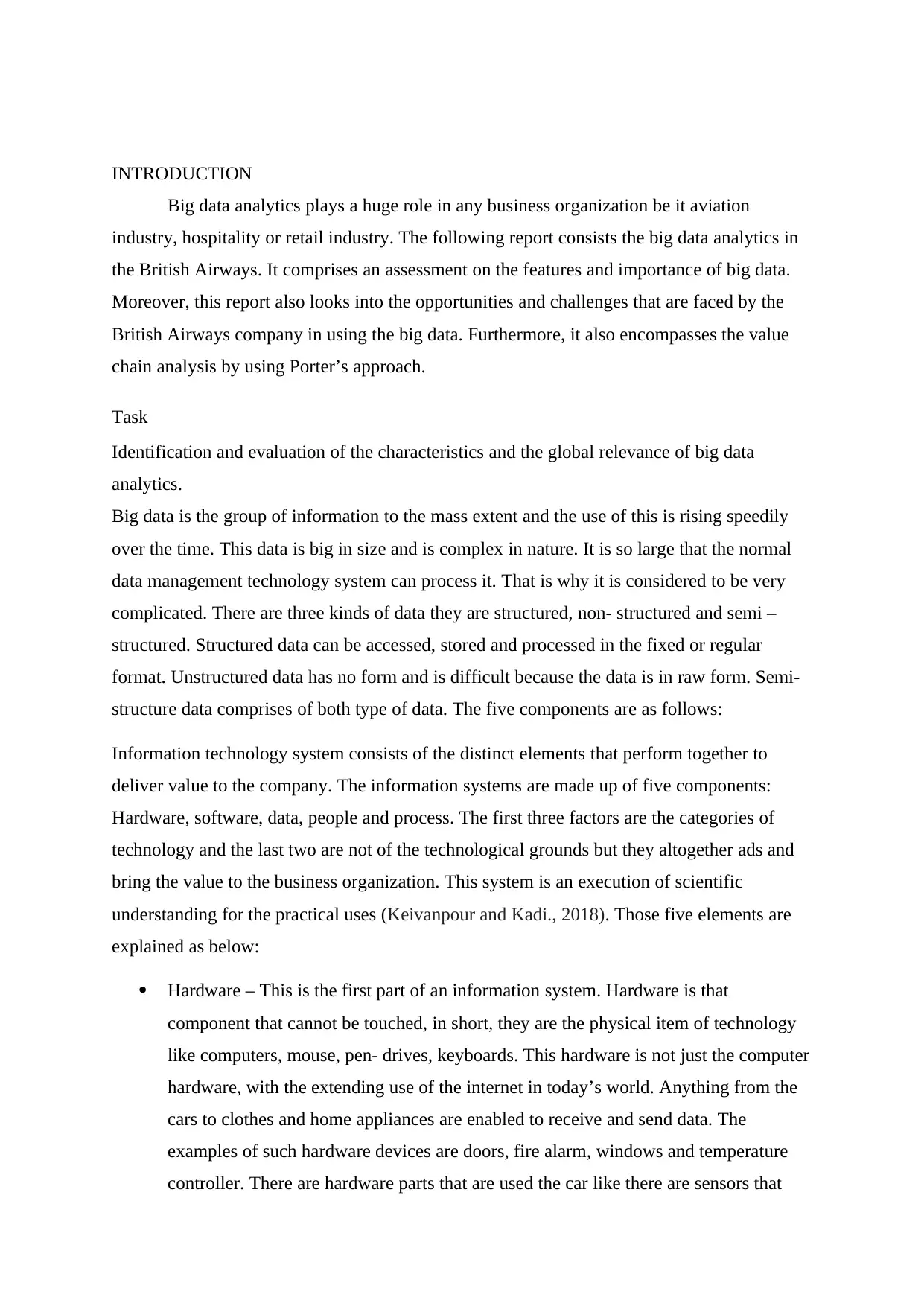
INTRODUCTION
Big data analytics plays a huge role in any business organization be it aviation
industry, hospitality or retail industry. The following report consists the big data analytics in
the British Airways. It comprises an assessment on the features and importance of big data.
Moreover, this report also looks into the opportunities and challenges that are faced by the
British Airways company in using the big data. Furthermore, it also encompasses the value
chain analysis by using Porter’s approach.
Task
Identification and evaluation of the characteristics and the global relevance of big data
analytics.
Big data is the group of information to the mass extent and the use of this is rising speedily
over the time. This data is big in size and is complex in nature. It is so large that the normal
data management technology system can process it. That is why it is considered to be very
complicated. There are three kinds of data they are structured, non- structured and semi –
structured. Structured data can be accessed, stored and processed in the fixed or regular
format. Unstructured data has no form and is difficult because the data is in raw form. Semi-
structure data comprises of both type of data. The five components are as follows:
Information technology system consists of the distinct elements that perform together to
deliver value to the company. The information systems are made up of five components:
Hardware, software, data, people and process. The first three factors are the categories of
technology and the last two are not of the technological grounds but they altogether ads and
bring the value to the business organization. This system is an execution of scientific
understanding for the practical uses (Keivanpour and Kadi., 2018). Those five elements are
explained as below:
Hardware – This is the first part of an information system. Hardware is that
component that cannot be touched, in short, they are the physical item of technology
like computers, mouse, pen- drives, keyboards. This hardware is not just the computer
hardware, with the extending use of the internet in today’s world. Anything from the
cars to clothes and home appliances are enabled to receive and send data. The
examples of such hardware devices are doors, fire alarm, windows and temperature
controller. There are hardware parts that are used the car like there are sensors that
Big data analytics plays a huge role in any business organization be it aviation
industry, hospitality or retail industry. The following report consists the big data analytics in
the British Airways. It comprises an assessment on the features and importance of big data.
Moreover, this report also looks into the opportunities and challenges that are faced by the
British Airways company in using the big data. Furthermore, it also encompasses the value
chain analysis by using Porter’s approach.
Task
Identification and evaluation of the characteristics and the global relevance of big data
analytics.
Big data is the group of information to the mass extent and the use of this is rising speedily
over the time. This data is big in size and is complex in nature. It is so large that the normal
data management technology system can process it. That is why it is considered to be very
complicated. There are three kinds of data they are structured, non- structured and semi –
structured. Structured data can be accessed, stored and processed in the fixed or regular
format. Unstructured data has no form and is difficult because the data is in raw form. Semi-
structure data comprises of both type of data. The five components are as follows:
Information technology system consists of the distinct elements that perform together to
deliver value to the company. The information systems are made up of five components:
Hardware, software, data, people and process. The first three factors are the categories of
technology and the last two are not of the technological grounds but they altogether ads and
bring the value to the business organization. This system is an execution of scientific
understanding for the practical uses (Keivanpour and Kadi., 2018). Those five elements are
explained as below:
Hardware – This is the first part of an information system. Hardware is that
component that cannot be touched, in short, they are the physical item of technology
like computers, mouse, pen- drives, keyboards. This hardware is not just the computer
hardware, with the extending use of the internet in today’s world. Anything from the
cars to clothes and home appliances are enabled to receive and send data. The
examples of such hardware devices are doors, fire alarm, windows and temperature
controller. There are hardware parts that are used the car like there are sensors that
⊘ This is a preview!⊘
Do you want full access?
Subscribe today to unlock all pages.

Trusted by 1+ million students worldwide
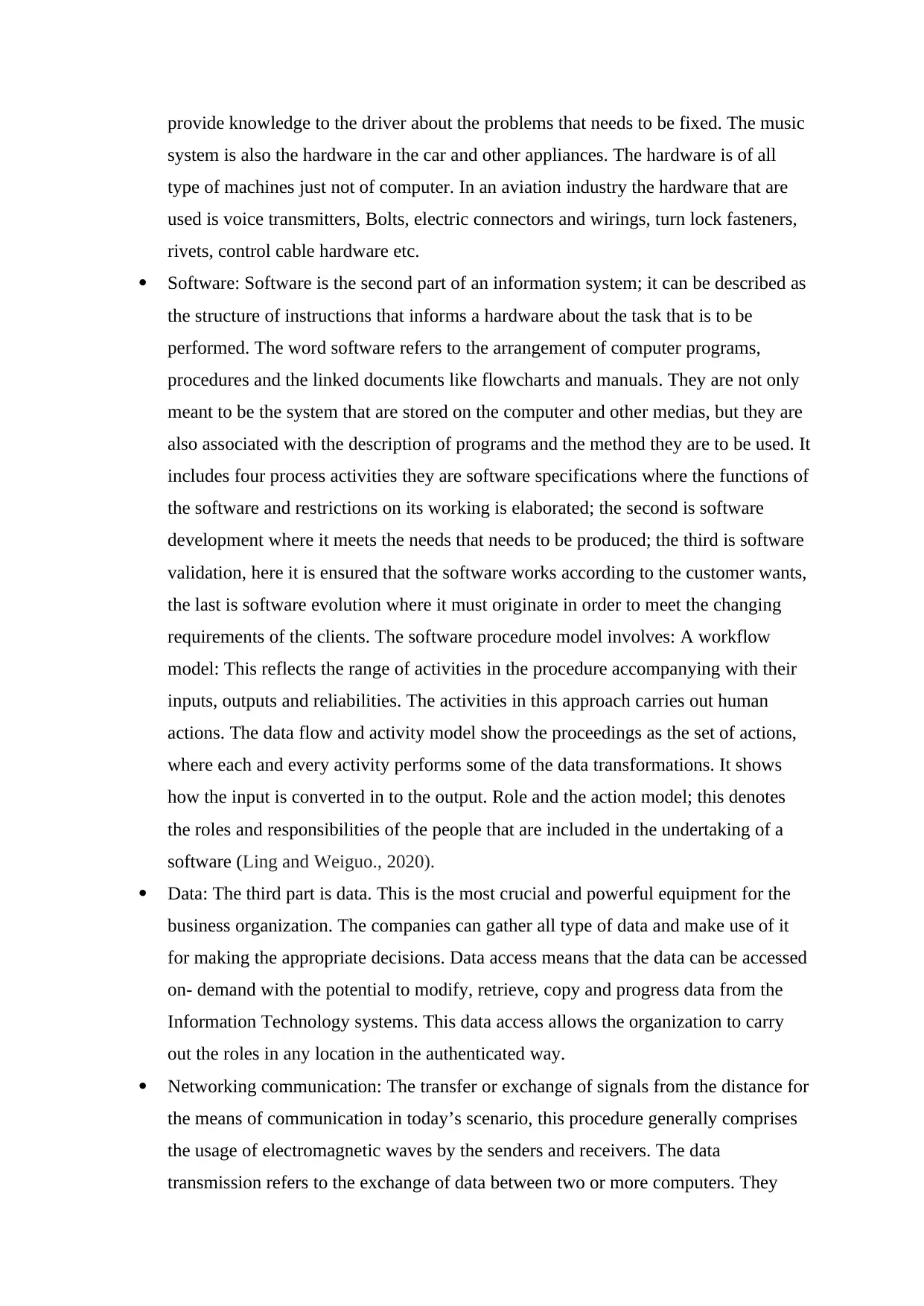
provide knowledge to the driver about the problems that needs to be fixed. The music
system is also the hardware in the car and other appliances. The hardware is of all
type of machines just not of computer. In an aviation industry the hardware that are
used is voice transmitters, Bolts, electric connectors and wirings, turn lock fasteners,
rivets, control cable hardware etc.
Software: Software is the second part of an information system; it can be described as
the structure of instructions that informs a hardware about the task that is to be
performed. The word software refers to the arrangement of computer programs,
procedures and the linked documents like flowcharts and manuals. They are not only
meant to be the system that are stored on the computer and other medias, but they are
also associated with the description of programs and the method they are to be used. It
includes four process activities they are software specifications where the functions of
the software and restrictions on its working is elaborated; the second is software
development where it meets the needs that needs to be produced; the third is software
validation, here it is ensured that the software works according to the customer wants,
the last is software evolution where it must originate in order to meet the changing
requirements of the clients. The software procedure model involves: A workflow
model: This reflects the range of activities in the procedure accompanying with their
inputs, outputs and reliabilities. The activities in this approach carries out human
actions. The data flow and activity model show the proceedings as the set of actions,
where each and every activity performs some of the data transformations. It shows
how the input is converted in to the output. Role and the action model; this denotes
the roles and responsibilities of the people that are included in the undertaking of a
software (Ling and Weiguo., 2020).
Data: The third part is data. This is the most crucial and powerful equipment for the
business organization. The companies can gather all type of data and make use of it
for making the appropriate decisions. Data access means that the data can be accessed
on- demand with the potential to modify, retrieve, copy and progress data from the
Information Technology systems. This data access allows the organization to carry
out the roles in any location in the authenticated way.
Networking communication: The transfer or exchange of signals from the distance for
the means of communication in today’s scenario, this procedure generally comprises
the usage of electromagnetic waves by the senders and receivers. The data
transmission refers to the exchange of data between two or more computers. They
system is also the hardware in the car and other appliances. The hardware is of all
type of machines just not of computer. In an aviation industry the hardware that are
used is voice transmitters, Bolts, electric connectors and wirings, turn lock fasteners,
rivets, control cable hardware etc.
Software: Software is the second part of an information system; it can be described as
the structure of instructions that informs a hardware about the task that is to be
performed. The word software refers to the arrangement of computer programs,
procedures and the linked documents like flowcharts and manuals. They are not only
meant to be the system that are stored on the computer and other medias, but they are
also associated with the description of programs and the method they are to be used. It
includes four process activities they are software specifications where the functions of
the software and restrictions on its working is elaborated; the second is software
development where it meets the needs that needs to be produced; the third is software
validation, here it is ensured that the software works according to the customer wants,
the last is software evolution where it must originate in order to meet the changing
requirements of the clients. The software procedure model involves: A workflow
model: This reflects the range of activities in the procedure accompanying with their
inputs, outputs and reliabilities. The activities in this approach carries out human
actions. The data flow and activity model show the proceedings as the set of actions,
where each and every activity performs some of the data transformations. It shows
how the input is converted in to the output. Role and the action model; this denotes
the roles and responsibilities of the people that are included in the undertaking of a
software (Ling and Weiguo., 2020).
Data: The third part is data. This is the most crucial and powerful equipment for the
business organization. The companies can gather all type of data and make use of it
for making the appropriate decisions. Data access means that the data can be accessed
on- demand with the potential to modify, retrieve, copy and progress data from the
Information Technology systems. This data access allows the organization to carry
out the roles in any location in the authenticated way.
Networking communication: The transfer or exchange of signals from the distance for
the means of communication in today’s scenario, this procedure generally comprises
the usage of electromagnetic waves by the senders and receivers. The data
transmission refers to the exchange of data between two or more computers. They
Paraphrase This Document
Need a fresh take? Get an instant paraphrase of this document with our AI Paraphraser
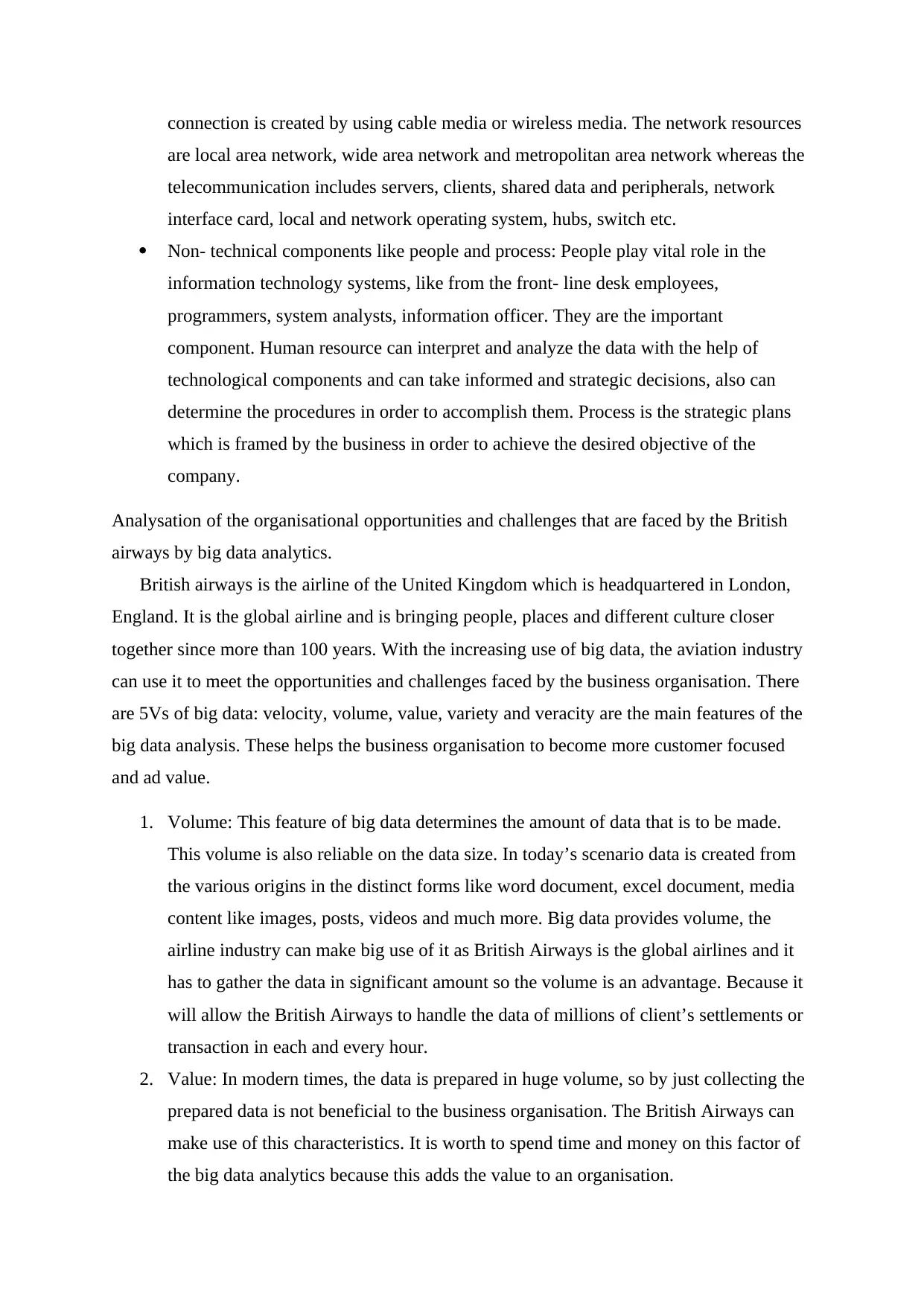
connection is created by using cable media or wireless media. The network resources
are local area network, wide area network and metropolitan area network whereas the
telecommunication includes servers, clients, shared data and peripherals, network
interface card, local and network operating system, hubs, switch etc.
Non- technical components like people and process: People play vital role in the
information technology systems, like from the front- line desk employees,
programmers, system analysts, information officer. They are the important
component. Human resource can interpret and analyze the data with the help of
technological components and can take informed and strategic decisions, also can
determine the procedures in order to accomplish them. Process is the strategic plans
which is framed by the business in order to achieve the desired objective of the
company.
Analysation of the organisational opportunities and challenges that are faced by the British
airways by big data analytics.
British airways is the airline of the United Kingdom which is headquartered in London,
England. It is the global airline and is bringing people, places and different culture closer
together since more than 100 years. With the increasing use of big data, the aviation industry
can use it to meet the opportunities and challenges faced by the business organisation. There
are 5Vs of big data: velocity, volume, value, variety and veracity are the main features of the
big data analysis. These helps the business organisation to become more customer focused
and ad value.
1. Volume: This feature of big data determines the amount of data that is to be made.
This volume is also reliable on the data size. In today’s scenario data is created from
the various origins in the distinct forms like word document, excel document, media
content like images, posts, videos and much more. Big data provides volume, the
airline industry can make big use of it as British Airways is the global airlines and it
has to gather the data in significant amount so the volume is an advantage. Because it
will allow the British Airways to handle the data of millions of client’s settlements or
transaction in each and every hour.
2. Value: In modern times, the data is prepared in huge volume, so by just collecting the
prepared data is not beneficial to the business organisation. The British Airways can
make use of this characteristics. It is worth to spend time and money on this factor of
the big data analytics because this adds the value to an organisation.
are local area network, wide area network and metropolitan area network whereas the
telecommunication includes servers, clients, shared data and peripherals, network
interface card, local and network operating system, hubs, switch etc.
Non- technical components like people and process: People play vital role in the
information technology systems, like from the front- line desk employees,
programmers, system analysts, information officer. They are the important
component. Human resource can interpret and analyze the data with the help of
technological components and can take informed and strategic decisions, also can
determine the procedures in order to accomplish them. Process is the strategic plans
which is framed by the business in order to achieve the desired objective of the
company.
Analysation of the organisational opportunities and challenges that are faced by the British
airways by big data analytics.
British airways is the airline of the United Kingdom which is headquartered in London,
England. It is the global airline and is bringing people, places and different culture closer
together since more than 100 years. With the increasing use of big data, the aviation industry
can use it to meet the opportunities and challenges faced by the business organisation. There
are 5Vs of big data: velocity, volume, value, variety and veracity are the main features of the
big data analysis. These helps the business organisation to become more customer focused
and ad value.
1. Volume: This feature of big data determines the amount of data that is to be made.
This volume is also reliable on the data size. In today’s scenario data is created from
the various origins in the distinct forms like word document, excel document, media
content like images, posts, videos and much more. Big data provides volume, the
airline industry can make big use of it as British Airways is the global airlines and it
has to gather the data in significant amount so the volume is an advantage. Because it
will allow the British Airways to handle the data of millions of client’s settlements or
transaction in each and every hour.
2. Value: In modern times, the data is prepared in huge volume, so by just collecting the
prepared data is not beneficial to the business organisation. The British Airways can
make use of this characteristics. It is worth to spend time and money on this factor of
the big data analytics because this adds the value to an organisation.
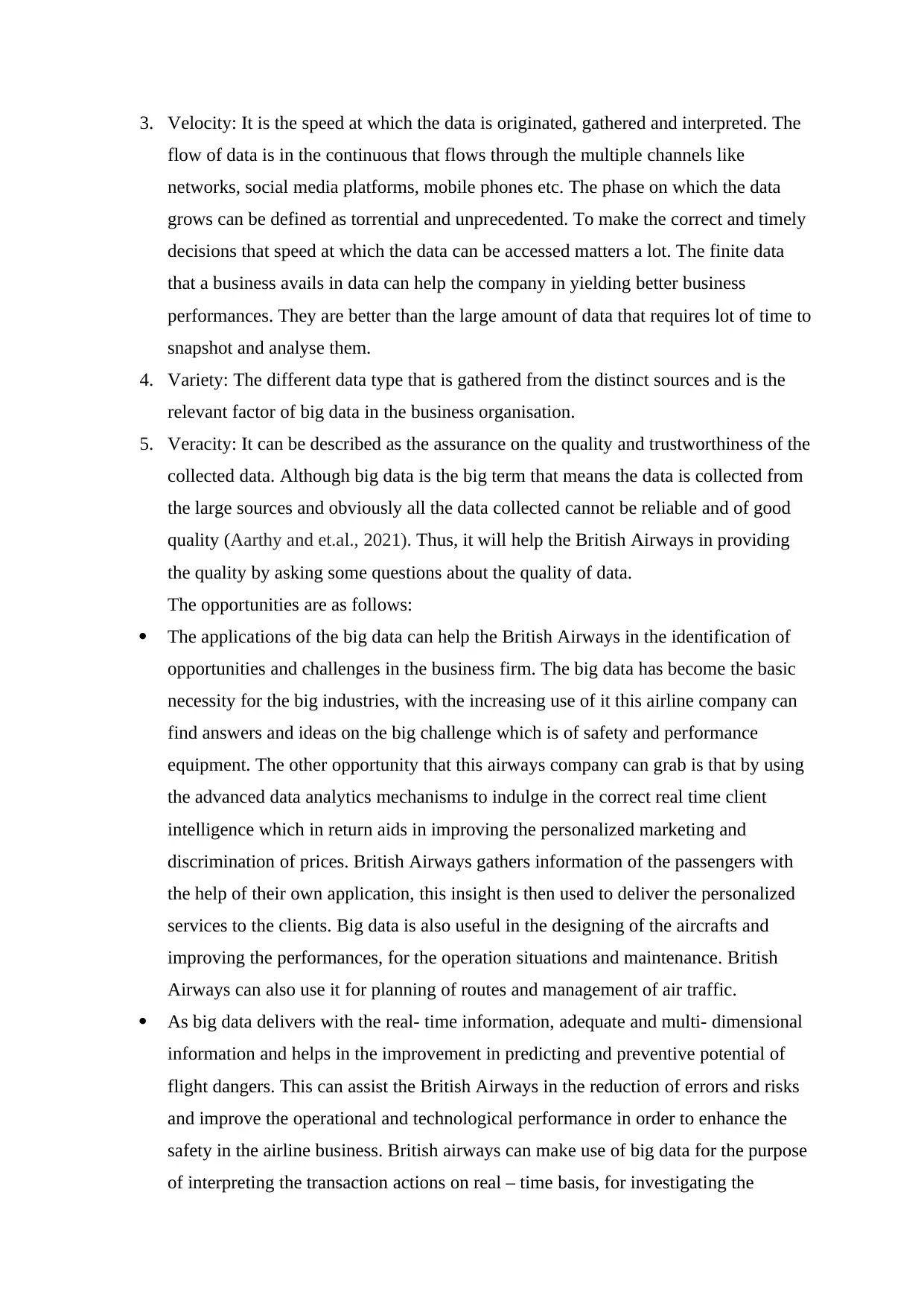
3. Velocity: It is the speed at which the data is originated, gathered and interpreted. The
flow of data is in the continuous that flows through the multiple channels like
networks, social media platforms, mobile phones etc. The phase on which the data
grows can be defined as torrential and unprecedented. To make the correct and timely
decisions that speed at which the data can be accessed matters a lot. The finite data
that a business avails in data can help the company in yielding better business
performances. They are better than the large amount of data that requires lot of time to
snapshot and analyse them.
4. Variety: The different data type that is gathered from the distinct sources and is the
relevant factor of big data in the business organisation.
5. Veracity: It can be described as the assurance on the quality and trustworthiness of the
collected data. Although big data is the big term that means the data is collected from
the large sources and obviously all the data collected cannot be reliable and of good
quality (Aarthy and et.al., 2021). Thus, it will help the British Airways in providing
the quality by asking some questions about the quality of data.
The opportunities are as follows:
The applications of the big data can help the British Airways in the identification of
opportunities and challenges in the business firm. The big data has become the basic
necessity for the big industries, with the increasing use of it this airline company can
find answers and ideas on the big challenge which is of safety and performance
equipment. The other opportunity that this airways company can grab is that by using
the advanced data analytics mechanisms to indulge in the correct real time client
intelligence which in return aids in improving the personalized marketing and
discrimination of prices. British Airways gathers information of the passengers with
the help of their own application, this insight is then used to deliver the personalized
services to the clients. Big data is also useful in the designing of the aircrafts and
improving the performances, for the operation situations and maintenance. British
Airways can also use it for planning of routes and management of air traffic.
As big data delivers with the real- time information, adequate and multi- dimensional
information and helps in the improvement in predicting and preventive potential of
flight dangers. This can assist the British Airways in the reduction of errors and risks
and improve the operational and technological performance in order to enhance the
safety in the airline business. British airways can make use of big data for the purpose
of interpreting the transaction actions on real – time basis, for investigating the
flow of data is in the continuous that flows through the multiple channels like
networks, social media platforms, mobile phones etc. The phase on which the data
grows can be defined as torrential and unprecedented. To make the correct and timely
decisions that speed at which the data can be accessed matters a lot. The finite data
that a business avails in data can help the company in yielding better business
performances. They are better than the large amount of data that requires lot of time to
snapshot and analyse them.
4. Variety: The different data type that is gathered from the distinct sources and is the
relevant factor of big data in the business organisation.
5. Veracity: It can be described as the assurance on the quality and trustworthiness of the
collected data. Although big data is the big term that means the data is collected from
the large sources and obviously all the data collected cannot be reliable and of good
quality (Aarthy and et.al., 2021). Thus, it will help the British Airways in providing
the quality by asking some questions about the quality of data.
The opportunities are as follows:
The applications of the big data can help the British Airways in the identification of
opportunities and challenges in the business firm. The big data has become the basic
necessity for the big industries, with the increasing use of it this airline company can
find answers and ideas on the big challenge which is of safety and performance
equipment. The other opportunity that this airways company can grab is that by using
the advanced data analytics mechanisms to indulge in the correct real time client
intelligence which in return aids in improving the personalized marketing and
discrimination of prices. British Airways gathers information of the passengers with
the help of their own application, this insight is then used to deliver the personalized
services to the clients. Big data is also useful in the designing of the aircrafts and
improving the performances, for the operation situations and maintenance. British
Airways can also use it for planning of routes and management of air traffic.
As big data delivers with the real- time information, adequate and multi- dimensional
information and helps in the improvement in predicting and preventive potential of
flight dangers. This can assist the British Airways in the reduction of errors and risks
and improve the operational and technological performance in order to enhance the
safety in the airline business. British airways can make use of big data for the purpose
of interpreting the transaction actions on real – time basis, for investigating the
⊘ This is a preview!⊘
Do you want full access?
Subscribe today to unlock all pages.

Trusted by 1+ million students worldwide
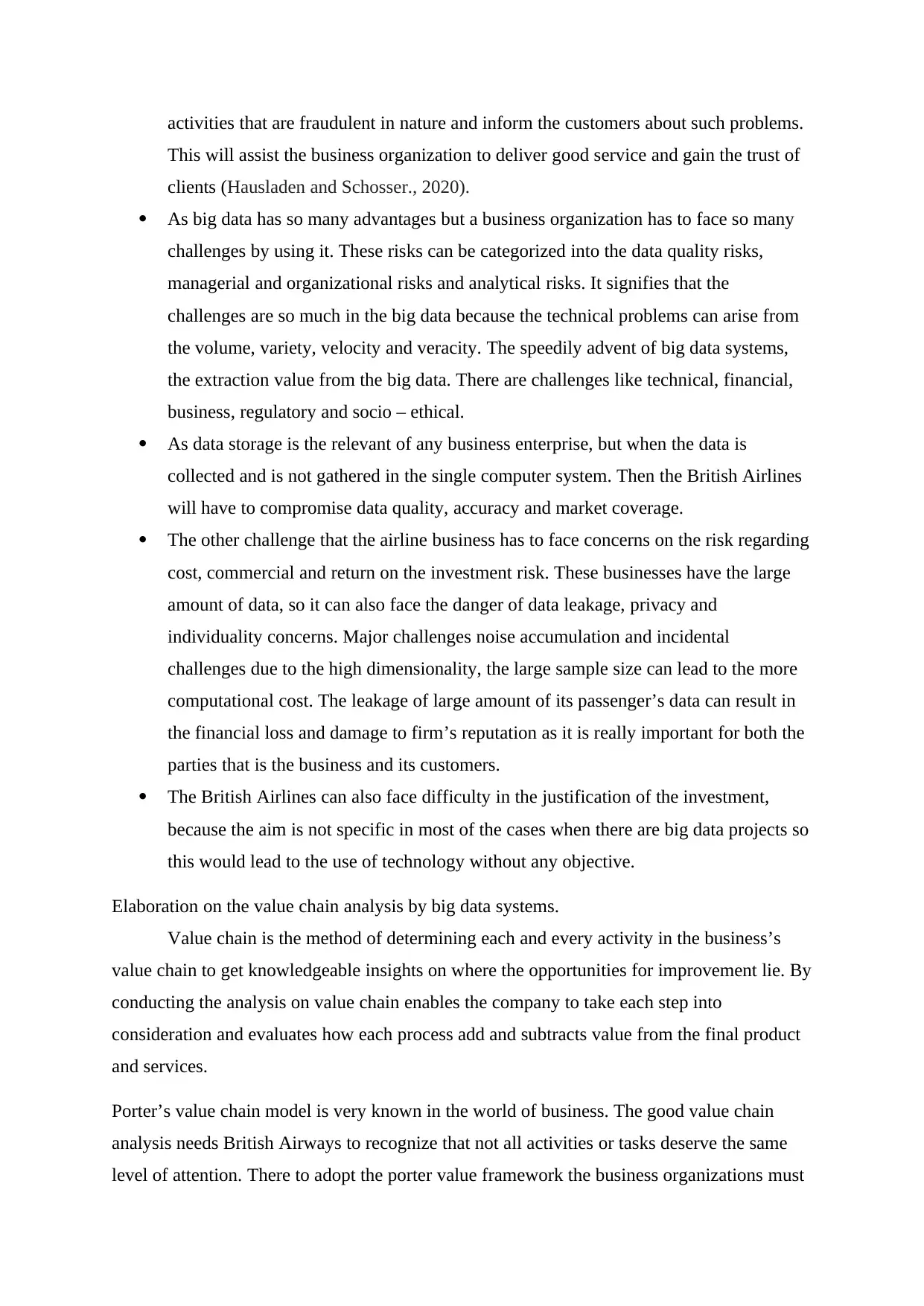
activities that are fraudulent in nature and inform the customers about such problems.
This will assist the business organization to deliver good service and gain the trust of
clients (Hausladen and Schosser., 2020).
As big data has so many advantages but a business organization has to face so many
challenges by using it. These risks can be categorized into the data quality risks,
managerial and organizational risks and analytical risks. It signifies that the
challenges are so much in the big data because the technical problems can arise from
the volume, variety, velocity and veracity. The speedily advent of big data systems,
the extraction value from the big data. There are challenges like technical, financial,
business, regulatory and socio – ethical.
As data storage is the relevant of any business enterprise, but when the data is
collected and is not gathered in the single computer system. Then the British Airlines
will have to compromise data quality, accuracy and market coverage.
The other challenge that the airline business has to face concerns on the risk regarding
cost, commercial and return on the investment risk. These businesses have the large
amount of data, so it can also face the danger of data leakage, privacy and
individuality concerns. Major challenges noise accumulation and incidental
challenges due to the high dimensionality, the large sample size can lead to the more
computational cost. The leakage of large amount of its passenger’s data can result in
the financial loss and damage to firm’s reputation as it is really important for both the
parties that is the business and its customers.
The British Airlines can also face difficulty in the justification of the investment,
because the aim is not specific in most of the cases when there are big data projects so
this would lead to the use of technology without any objective.
Elaboration on the value chain analysis by big data systems.
Value chain is the method of determining each and every activity in the business’s
value chain to get knowledgeable insights on where the opportunities for improvement lie. By
conducting the analysis on value chain enables the company to take each step into
consideration and evaluates how each process add and subtracts value from the final product
and services.
Porter’s value chain model is very known in the world of business. The good value chain
analysis needs British Airways to recognize that not all activities or tasks deserve the same
level of attention. There to adopt the porter value framework the business organizations must
This will assist the business organization to deliver good service and gain the trust of
clients (Hausladen and Schosser., 2020).
As big data has so many advantages but a business organization has to face so many
challenges by using it. These risks can be categorized into the data quality risks,
managerial and organizational risks and analytical risks. It signifies that the
challenges are so much in the big data because the technical problems can arise from
the volume, variety, velocity and veracity. The speedily advent of big data systems,
the extraction value from the big data. There are challenges like technical, financial,
business, regulatory and socio – ethical.
As data storage is the relevant of any business enterprise, but when the data is
collected and is not gathered in the single computer system. Then the British Airlines
will have to compromise data quality, accuracy and market coverage.
The other challenge that the airline business has to face concerns on the risk regarding
cost, commercial and return on the investment risk. These businesses have the large
amount of data, so it can also face the danger of data leakage, privacy and
individuality concerns. Major challenges noise accumulation and incidental
challenges due to the high dimensionality, the large sample size can lead to the more
computational cost. The leakage of large amount of its passenger’s data can result in
the financial loss and damage to firm’s reputation as it is really important for both the
parties that is the business and its customers.
The British Airlines can also face difficulty in the justification of the investment,
because the aim is not specific in most of the cases when there are big data projects so
this would lead to the use of technology without any objective.
Elaboration on the value chain analysis by big data systems.
Value chain is the method of determining each and every activity in the business’s
value chain to get knowledgeable insights on where the opportunities for improvement lie. By
conducting the analysis on value chain enables the company to take each step into
consideration and evaluates how each process add and subtracts value from the final product
and services.
Porter’s value chain model is very known in the world of business. The good value chain
analysis needs British Airways to recognize that not all activities or tasks deserve the same
level of attention. There to adopt the porter value framework the business organizations must
Paraphrase This Document
Need a fresh take? Get an instant paraphrase of this document with our AI Paraphraser
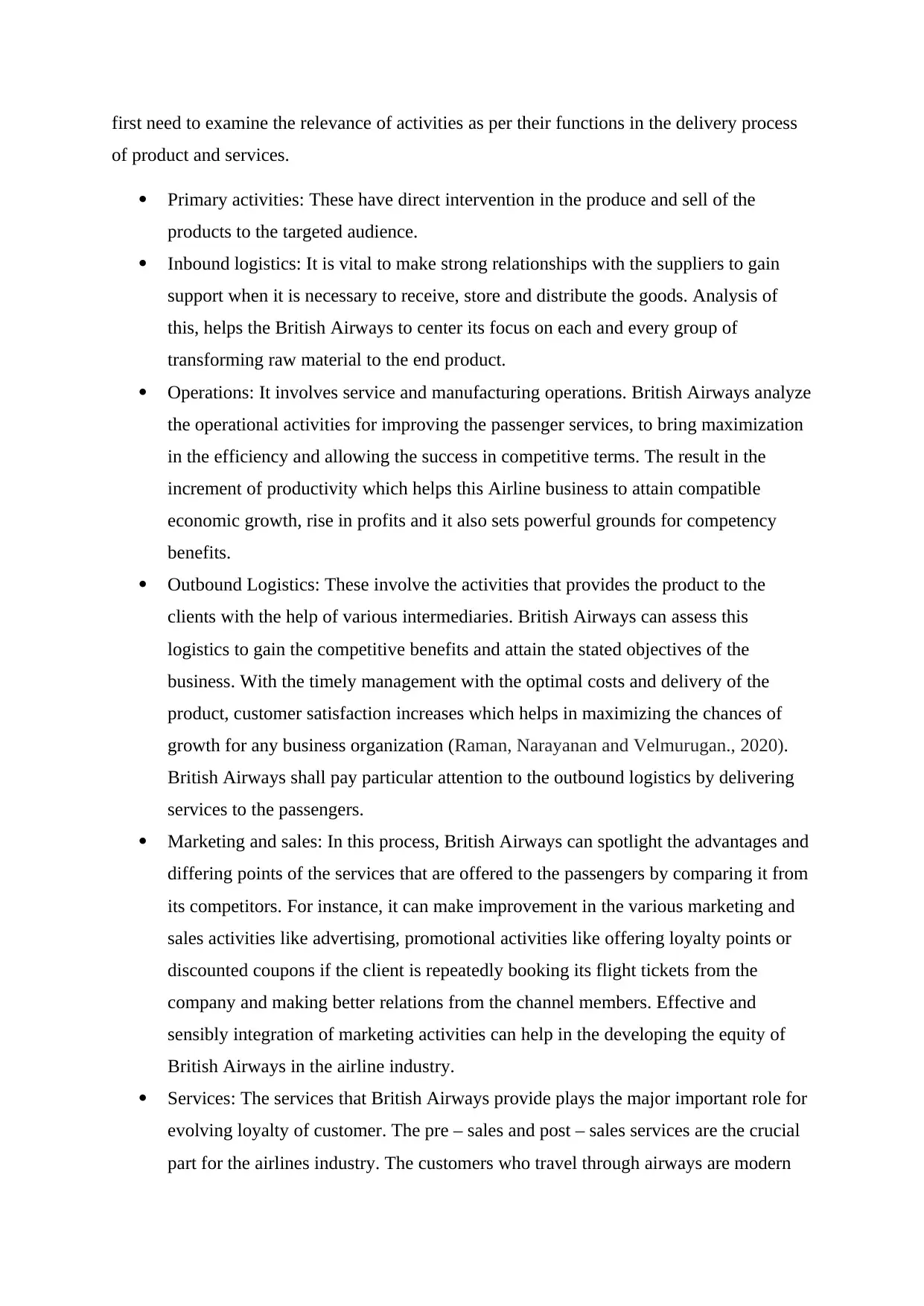
first need to examine the relevance of activities as per their functions in the delivery process
of product and services.
Primary activities: These have direct intervention in the produce and sell of the
products to the targeted audience.
Inbound logistics: It is vital to make strong relationships with the suppliers to gain
support when it is necessary to receive, store and distribute the goods. Analysis of
this, helps the British Airways to center its focus on each and every group of
transforming raw material to the end product.
Operations: It involves service and manufacturing operations. British Airways analyze
the operational activities for improving the passenger services, to bring maximization
in the efficiency and allowing the success in competitive terms. The result in the
increment of productivity which helps this Airline business to attain compatible
economic growth, rise in profits and it also sets powerful grounds for competency
benefits.
Outbound Logistics: These involve the activities that provides the product to the
clients with the help of various intermediaries. British Airways can assess this
logistics to gain the competitive benefits and attain the stated objectives of the
business. With the timely management with the optimal costs and delivery of the
product, customer satisfaction increases which helps in maximizing the chances of
growth for any business organization (Raman, Narayanan and Velmurugan., 2020).
British Airways shall pay particular attention to the outbound logistics by delivering
services to the passengers.
Marketing and sales: In this process, British Airways can spotlight the advantages and
differing points of the services that are offered to the passengers by comparing it from
its competitors. For instance, it can make improvement in the various marketing and
sales activities like advertising, promotional activities like offering loyalty points or
discounted coupons if the client is repeatedly booking its flight tickets from the
company and making better relations from the channel members. Effective and
sensibly integration of marketing activities can help in the developing the equity of
British Airways in the airline industry.
Services: The services that British Airways provide plays the major important role for
evolving loyalty of customer. The pre – sales and post – sales services are the crucial
part for the airlines industry. The customers who travel through airways are modern
of product and services.
Primary activities: These have direct intervention in the produce and sell of the
products to the targeted audience.
Inbound logistics: It is vital to make strong relationships with the suppliers to gain
support when it is necessary to receive, store and distribute the goods. Analysis of
this, helps the British Airways to center its focus on each and every group of
transforming raw material to the end product.
Operations: It involves service and manufacturing operations. British Airways analyze
the operational activities for improving the passenger services, to bring maximization
in the efficiency and allowing the success in competitive terms. The result in the
increment of productivity which helps this Airline business to attain compatible
economic growth, rise in profits and it also sets powerful grounds for competency
benefits.
Outbound Logistics: These involve the activities that provides the product to the
clients with the help of various intermediaries. British Airways can assess this
logistics to gain the competitive benefits and attain the stated objectives of the
business. With the timely management with the optimal costs and delivery of the
product, customer satisfaction increases which helps in maximizing the chances of
growth for any business organization (Raman, Narayanan and Velmurugan., 2020).
British Airways shall pay particular attention to the outbound logistics by delivering
services to the passengers.
Marketing and sales: In this process, British Airways can spotlight the advantages and
differing points of the services that are offered to the passengers by comparing it from
its competitors. For instance, it can make improvement in the various marketing and
sales activities like advertising, promotional activities like offering loyalty points or
discounted coupons if the client is repeatedly booking its flight tickets from the
company and making better relations from the channel members. Effective and
sensibly integration of marketing activities can help in the developing the equity of
British Airways in the airline industry.
Services: The services that British Airways provide plays the major important role for
evolving loyalty of customer. The pre – sales and post – sales services are the crucial
part for the airlines industry. The customers who travel through airways are modern
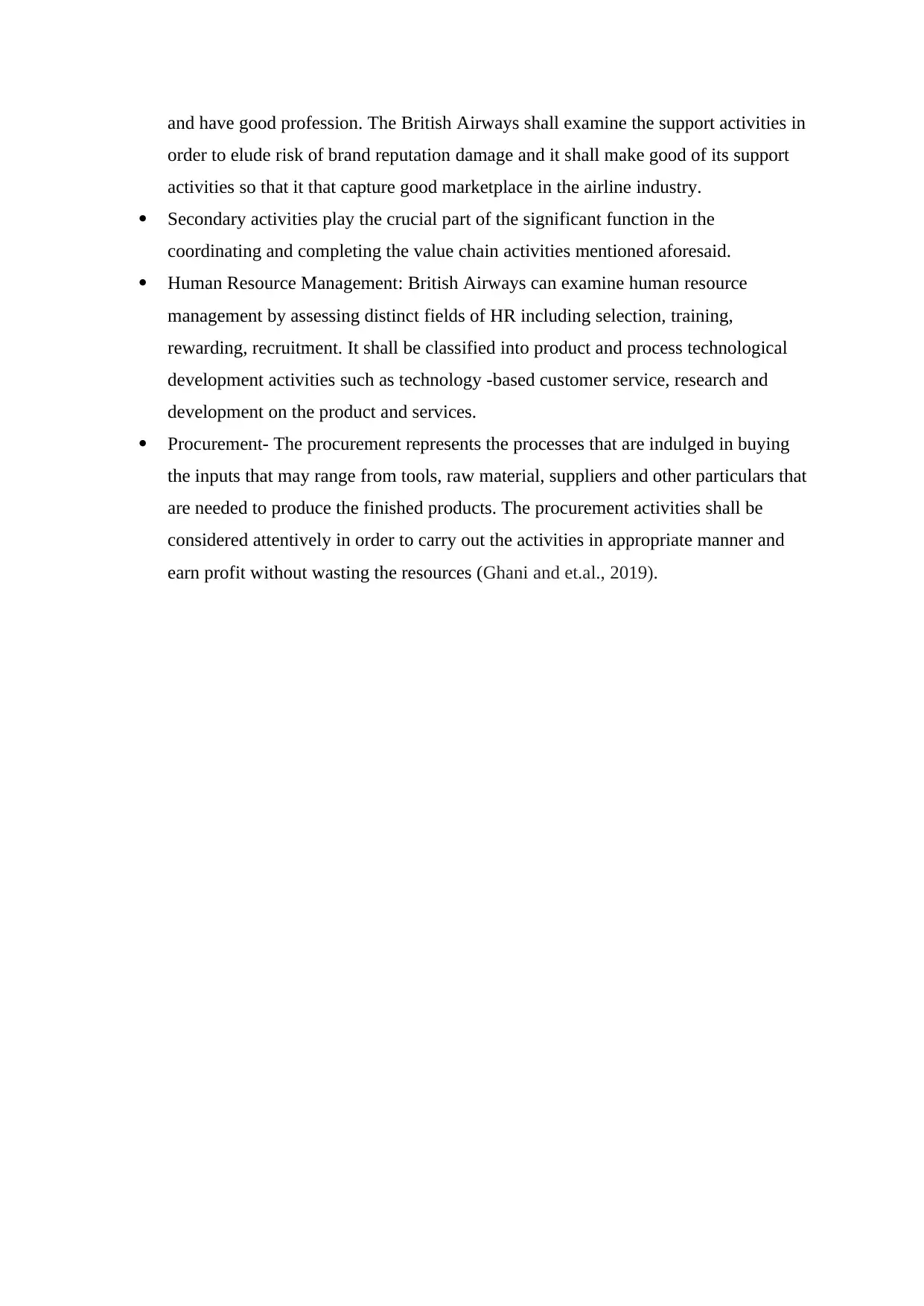
and have good profession. The British Airways shall examine the support activities in
order to elude risk of brand reputation damage and it shall make good of its support
activities so that it that capture good marketplace in the airline industry.
Secondary activities play the crucial part of the significant function in the
coordinating and completing the value chain activities mentioned aforesaid.
Human Resource Management: British Airways can examine human resource
management by assessing distinct fields of HR including selection, training,
rewarding, recruitment. It shall be classified into product and process technological
development activities such as technology -based customer service, research and
development on the product and services.
Procurement- The procurement represents the processes that are indulged in buying
the inputs that may range from tools, raw material, suppliers and other particulars that
are needed to produce the finished products. The procurement activities shall be
considered attentively in order to carry out the activities in appropriate manner and
earn profit without wasting the resources (Ghani and et.al., 2019).
order to elude risk of brand reputation damage and it shall make good of its support
activities so that it that capture good marketplace in the airline industry.
Secondary activities play the crucial part of the significant function in the
coordinating and completing the value chain activities mentioned aforesaid.
Human Resource Management: British Airways can examine human resource
management by assessing distinct fields of HR including selection, training,
rewarding, recruitment. It shall be classified into product and process technological
development activities such as technology -based customer service, research and
development on the product and services.
Procurement- The procurement represents the processes that are indulged in buying
the inputs that may range from tools, raw material, suppliers and other particulars that
are needed to produce the finished products. The procurement activities shall be
considered attentively in order to carry out the activities in appropriate manner and
earn profit without wasting the resources (Ghani and et.al., 2019).
⊘ This is a preview!⊘
Do you want full access?
Subscribe today to unlock all pages.

Trusted by 1+ million students worldwide
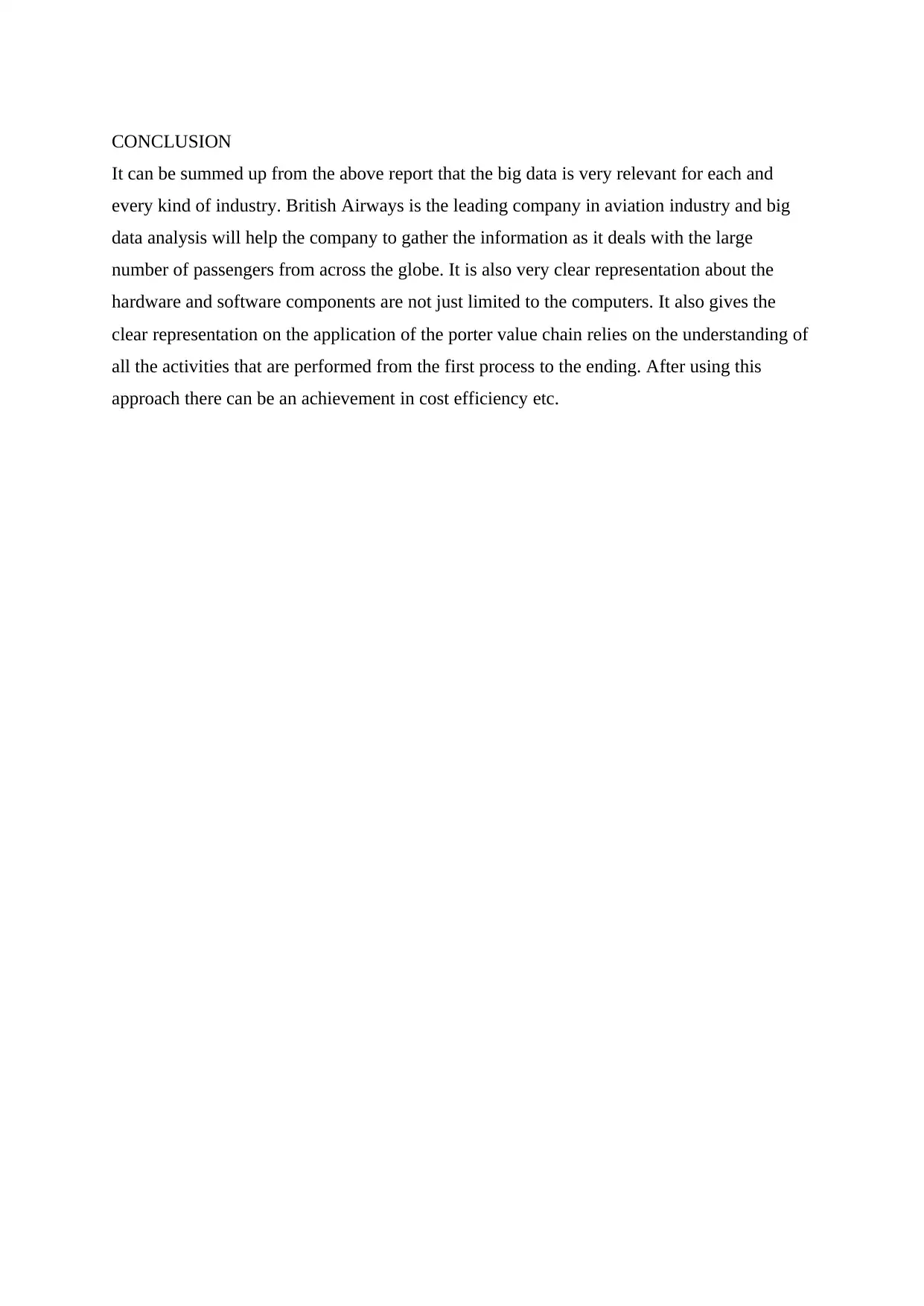
CONCLUSION
It can be summed up from the above report that the big data is very relevant for each and
every kind of industry. British Airways is the leading company in aviation industry and big
data analysis will help the company to gather the information as it deals with the large
number of passengers from across the globe. It is also very clear representation about the
hardware and software components are not just limited to the computers. It also gives the
clear representation on the application of the porter value chain relies on the understanding of
all the activities that are performed from the first process to the ending. After using this
approach there can be an achievement in cost efficiency etc.
It can be summed up from the above report that the big data is very relevant for each and
every kind of industry. British Airways is the leading company in aviation industry and big
data analysis will help the company to gather the information as it deals with the large
number of passengers from across the globe. It is also very clear representation about the
hardware and software components are not just limited to the computers. It also gives the
clear representation on the application of the porter value chain relies on the understanding of
all the activities that are performed from the first process to the ending. After using this
approach there can be an achievement in cost efficiency etc.
Paraphrase This Document
Need a fresh take? Get an instant paraphrase of this document with our AI Paraphraser
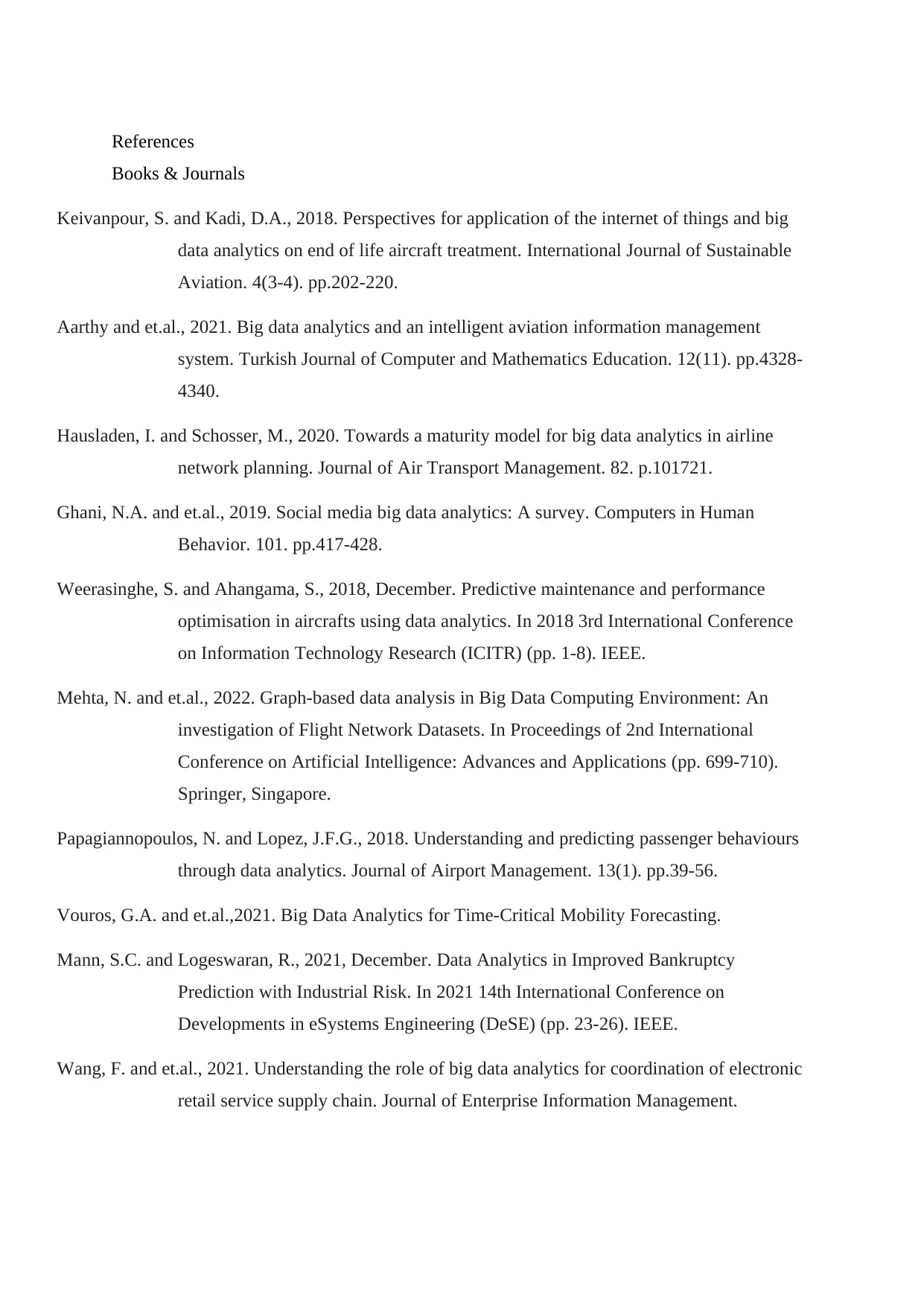
References
Books & Journals
Keivanpour, S. and Kadi, D.A., 2018. Perspectives for application of the internet of things and big
data analytics on end of life aircraft treatment. International Journal of Sustainable
Aviation. 4(3-4). pp.202-220.
Aarthy and et.al., 2021. Big data analytics and an intelligent aviation information management
system. Turkish Journal of Computer and Mathematics Education. 12(11). pp.4328-
4340.
Hausladen, I. and Schosser, M., 2020. Towards a maturity model for big data analytics in airline
network planning. Journal of Air Transport Management. 82. p.101721.
Ghani, N.A. and et.al., 2019. Social media big data analytics: A survey. Computers in Human
Behavior. 101. pp.417-428.
Weerasinghe, S. and Ahangama, S., 2018, December. Predictive maintenance and performance
optimisation in aircrafts using data analytics. In 2018 3rd International Conference
on Information Technology Research (ICITR) (pp. 1-8). IEEE.
Mehta, N. and et.al., 2022. Graph-based data analysis in Big Data Computing Environment: An
investigation of Flight Network Datasets. In Proceedings of 2nd International
Conference on Artificial Intelligence: Advances and Applications (pp. 699-710).
Springer, Singapore.
Papagiannopoulos, N. and Lopez, J.F.G., 2018. Understanding and predicting passenger behaviours
through data analytics. Journal of Airport Management. 13(1). pp.39-56.
Vouros, G.A. and et.al.,2021. Big Data Analytics for Time-Critical Mobility Forecasting.
Mann, S.C. and Logeswaran, R., 2021, December. Data Analytics in Improved Bankruptcy
Prediction with Industrial Risk. In 2021 14th International Conference on
Developments in eSystems Engineering (DeSE) (pp. 23-26). IEEE.
Wang, F. and et.al., 2021. Understanding the role of big data analytics for coordination of electronic
retail service supply chain. Journal of Enterprise Information Management.
Books & Journals
Keivanpour, S. and Kadi, D.A., 2018. Perspectives for application of the internet of things and big
data analytics on end of life aircraft treatment. International Journal of Sustainable
Aviation. 4(3-4). pp.202-220.
Aarthy and et.al., 2021. Big data analytics and an intelligent aviation information management
system. Turkish Journal of Computer and Mathematics Education. 12(11). pp.4328-
4340.
Hausladen, I. and Schosser, M., 2020. Towards a maturity model for big data analytics in airline
network planning. Journal of Air Transport Management. 82. p.101721.
Ghani, N.A. and et.al., 2019. Social media big data analytics: A survey. Computers in Human
Behavior. 101. pp.417-428.
Weerasinghe, S. and Ahangama, S., 2018, December. Predictive maintenance and performance
optimisation in aircrafts using data analytics. In 2018 3rd International Conference
on Information Technology Research (ICITR) (pp. 1-8). IEEE.
Mehta, N. and et.al., 2022. Graph-based data analysis in Big Data Computing Environment: An
investigation of Flight Network Datasets. In Proceedings of 2nd International
Conference on Artificial Intelligence: Advances and Applications (pp. 699-710).
Springer, Singapore.
Papagiannopoulos, N. and Lopez, J.F.G., 2018. Understanding and predicting passenger behaviours
through data analytics. Journal of Airport Management. 13(1). pp.39-56.
Vouros, G.A. and et.al.,2021. Big Data Analytics for Time-Critical Mobility Forecasting.
Mann, S.C. and Logeswaran, R., 2021, December. Data Analytics in Improved Bankruptcy
Prediction with Industrial Risk. In 2021 14th International Conference on
Developments in eSystems Engineering (DeSE) (pp. 23-26). IEEE.
Wang, F. and et.al., 2021. Understanding the role of big data analytics for coordination of electronic
retail service supply chain. Journal of Enterprise Information Management.
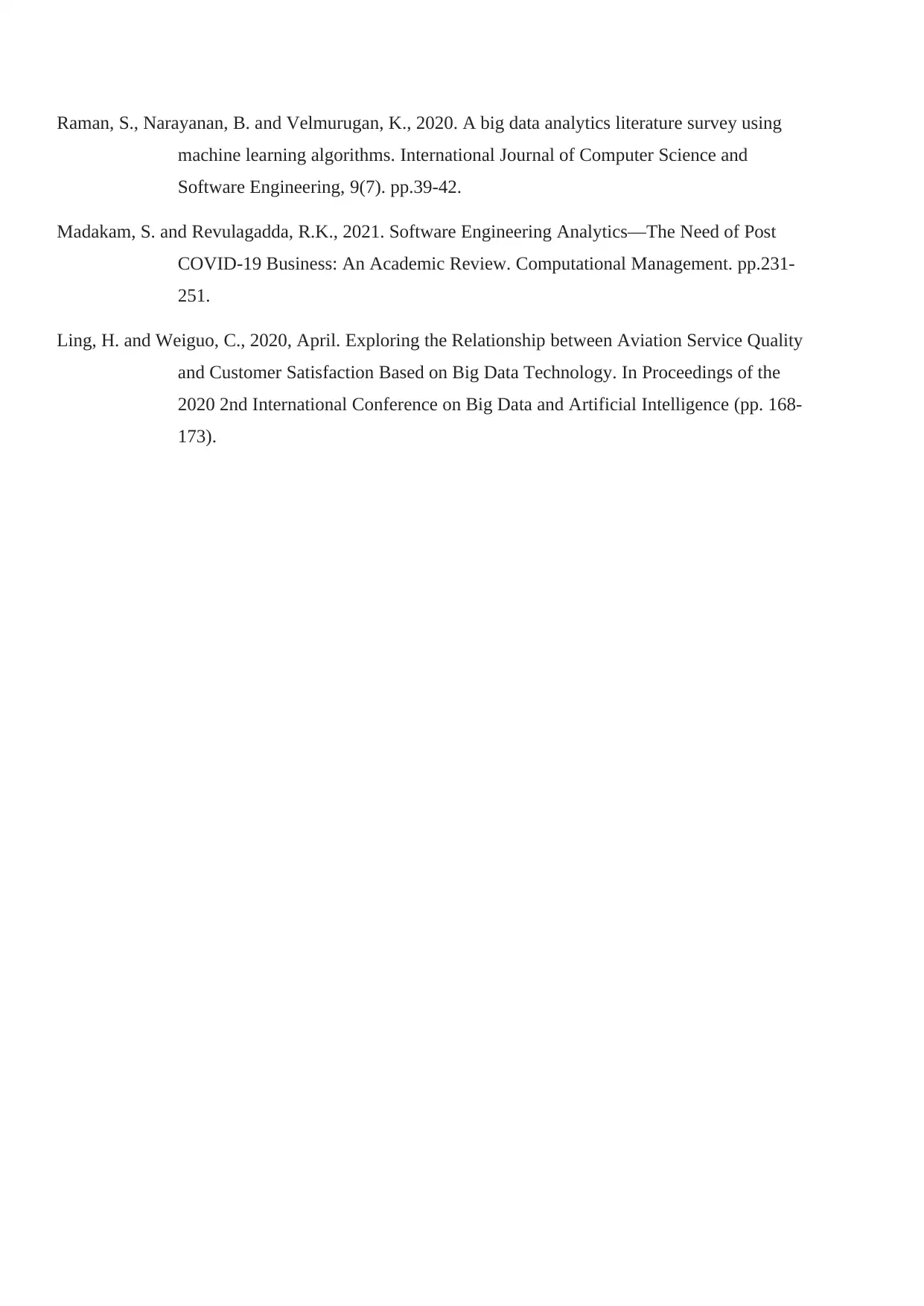
Raman, S., Narayanan, B. and Velmurugan, K., 2020. A big data analytics literature survey using
machine learning algorithms. International Journal of Computer Science and
Software Engineering, 9(7). pp.39-42.
Madakam, S. and Revulagadda, R.K., 2021. Software Engineering Analytics—The Need of Post
COVID-19 Business: An Academic Review. Computational Management. pp.231-
251.
Ling, H. and Weiguo, C., 2020, April. Exploring the Relationship between Aviation Service Quality
and Customer Satisfaction Based on Big Data Technology. In Proceedings of the
2020 2nd International Conference on Big Data and Artificial Intelligence (pp. 168-
173).
machine learning algorithms. International Journal of Computer Science and
Software Engineering, 9(7). pp.39-42.
Madakam, S. and Revulagadda, R.K., 2021. Software Engineering Analytics—The Need of Post
COVID-19 Business: An Academic Review. Computational Management. pp.231-
251.
Ling, H. and Weiguo, C., 2020, April. Exploring the Relationship between Aviation Service Quality
and Customer Satisfaction Based on Big Data Technology. In Proceedings of the
2020 2nd International Conference on Big Data and Artificial Intelligence (pp. 168-
173).
⊘ This is a preview!⊘
Do you want full access?
Subscribe today to unlock all pages.

Trusted by 1+ million students worldwide
1 out of 12
Related Documents
Your All-in-One AI-Powered Toolkit for Academic Success.
+13062052269
info@desklib.com
Available 24*7 on WhatsApp / Email
![[object Object]](/_next/static/media/star-bottom.7253800d.svg)
Unlock your academic potential
Copyright © 2020–2025 A2Z Services. All Rights Reserved. Developed and managed by ZUCOL.


